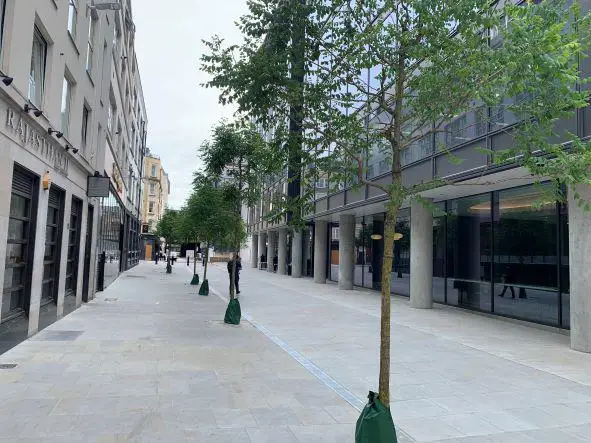Cool streets and greening in the Square Mile
The Climate Action Strategy has established a Cool Streets and Greening project to improve the resilience of streets, parks and open spaces to mitigate the impacts of climate change.
We must adapt our environment to make it receptive to changes in the climate. Projections predict that the City will experience higher temperatures and longer periods of heatwaves and drought in the future if no work is done to prevent this.
Increasing hot weather days in the UK have reinforced the importance of having shade and cool spaces in the City. Flooding and more frequent extreme weather events like heavy rainfall have highlighted the need to manage surface water more effectively. The likelihood of new pests and diseases increase with these warming temperatures.
These resilience measures will help us achieve:
- A range of urban greening, climate-resilient planting projects
- A number of sustainable drainage projects
- Sensor-based environmental monitoring, to evaluate the effectiveness of the measures
This project is being delivered in four phases.

Phase 1 of the project identified existing schemes where additional funding could improve the climate resilience of them. These include:
- Avenue of street trees on Vine Street to provide a shaded route to eliminate street-level overheating. Vine trees were select for their resistance to pests and diseases. Completed March 2022.
- Drought tolerant planting at the riverside planters outside the City of London School. Completed May 2022.
- Sustainable drainage and tree planting close to the junction of Bevis Marks, Dukes Place and Creechurch Lane, supporting the City Cluster Vision. Completed April 2023.
- Permeable paving and climate resilient planting as part of the Greening Cheapside Sunken Garden project. Completed July 2024.
- In-ground, climate resilient planting, new trees and sustainable drainage as part of the City Cluster Vision Jubilee Gardens improvements. Completed February 2025.
- Trials of climate resilient planting in a number of planters and parklets.
Phase 2 followed a similar approach to Phase 1, with sites identified at a slightly earlier stage of design. The projects identified in this phase were:
- Street trees, in-ground planters and rain gardens along Queen Victoria Street as part of the All Change at Bank project.
- Rain gardens, channels and footway reprofiling for surface water management, and new trees and hedge planting at Little Trinity Lane.
- Climate resilient, biodiverse planting, trees for shade and permeable paving as part of a new green space in the existing carriageway at Crescent/100 Minories.
- Environmental monitoring of Phase 2 of the Barbican Podium Renewal.
Phase 3 of the programme identified new locations across the City to plant trees, increase the resilience of gardens and planting to mitigate the risks of climate change and promote biodiversity. Alongside an ambition to convert more grey areas to green. The aims are to improve the quality and connectivity of the City’s green spaces, and target improvements at the most important ecological sites, known as Sites of Importance for Nature Conservation. To achieve this Phase 3 will:
- Undertake an ambitious programme of tree planting across the Square Mile between 2023 and 2025.
- Review planting in a number of City Gardens to improve its climate resilience and biodiversity value.
- Extend green space and soft landscaping at five priority locations.
SuDS are effective for managing surface water resulting from rainfall and help to minimise the risks of flooding from surcharged sewers. We are developing proposals for greening and creating SuDS across several sites in the Square Mile.
Phase 4 of the cool streets and greening programme involves designing SuDs schemes for up to ten locations between 2023 and 2026. Some of the locations with proposed developments:
- Ludgate Broadway: creating a rain garden, planting trees, widening pavement and raising carriageways and crossings at junctions. We will replace the temporary ‘parklet’ with a permanent design.
- St Andrews Hill: creating a rain garden, planting trees, relocating cycle stands and a parking bay.
- Bread Street: creating a rain garden, planting trees, relocating cycle stands.
- Knightrider Court: extending the pavement in front of the café, creating a rain garden and relocating disabled parking bays.
- St Andrew Undershaft Churchyard: to harvest rainwater from the Church roof to water new planters and planting beds. We will add more seating and improve the layout.
The project is due to start in early 2025 and is estimated to take approximately five months. If you have any comments about the proposals, please contact the Policy Projects Team.
Underground space in the City is often congested, filled with utilities, basements, tunnels, railways and archaeological remains. This means that some climate resilience projects, such as tree planting and sustainable drainage, can be more complex than anticipated.
The City Corporation, in partnership with the British Geological Survey and the UK Climate Resilience Programme, carried out a year-long research project to better understand how underground space can be used to improve resilience to climate change. Read more about the Cubic Mile project .
The project finished in November 2022 with a policy summary and recommendations for implementation published on the NERC Open Research Archive.
Plans for Phase 4 - Sustainable Drainage Systems (SuDs)



